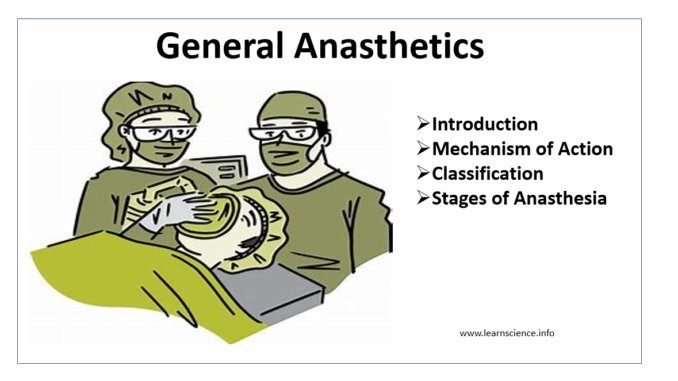
General Anesthetics
General Anesthetics are used to induce reversible loss of consciousness in humans or loss of righting reflex in animals. They are mostly used to depress CNS (Central Nervous System) for performance of surgery and other unpleasant procedures. They cause loss of all modalities of sensation, specially pain. General anesthetics have low therapeutic index and so should be administered with great care.
Classification of general anesthetics
i)Volatile Liquids- e.g. Halothane, Diethyl ether, Ethyl chloride, Isoflurane
ii)Gases- e.g. Nitrous oxide
- Intravenous general Anesthetics
i)Benzodiazepines- Diazepam
ii)Ultra- short acting barbiturates- e.g. Thiopental sodium, Methohexital
iii)Opioid Analgesic- e.g. Morphine
iv)Phencyclidine derivative- e.g. Ketamine
v)Miscelleneous- e.g. Etomidate
Mechanism of action of General Anesthetics
Clinical effects of general anesthetics depend on their chemical structures, their ability to localize within CNS and interact with target sites. Specific cortical areas exhibit different sensitivity to different anesthetics. Spinal cord mostly mediate inhibition of motor response to pain. Behavioral and physiological effects like amnesia and hypnosis are mediated by midbrain, reticular activating system, pons, amygdala, thalamus and hippocampus.
A number of inhalation and intravenous anesthetics directly hyperpolarize motor neurons. The potency of these agents in hyperpolarizing the motor neurons is directly related to their anesthetic potency. Inhalation anesthetics hyperpolarize neurons which causes reduced excitability in postsynaptic neurons thus diminishing the chances of action potential initiation in response to neurotransmitter release. Both inhalation and intravenous anesthetics, at anesthetizing concentration have substantial effect on synaptic transmission and less effect on action potential generation and propagation.
Current evidence suggests that molecular targets for anesthetic agents are primarily proteins of neuronal ligand gated ion channels associated with nicotinic receptors, 5-HT3, NMDA and GABAA. Specific receptors may vary according to anesthetics. GABAA is for most IV anesthetics, NMDA for ketamine and nicotinic receptors and NMDA for nitrous oxide.
Stages of Anesthesia
There are four stages of anesthesia. Various stages of anesthesia were first described by Guedel in 1920.
1)Stage I or Stage of analgesia
2)Stage II or Stage of delirium
3)Stage III or Stage of surgical anesthesia
4)Stage IV or Stage of medullary paralysis
1)Stage of analgesia–
It begins with induction of anesthesia to loss of consciousness. Before loss of consciousness, stage of analgesia is produced. This stage is suitable for performing minor surgeries like tooth extraction, incision of an abscess, obstetrical maneuvers. It is difficult to maintain it for long time.
2) Stage of delirium –
It is also known as stage of excitement and lasts from loss of consciousness to stage of surgical anesthesia. Excitement, shouting, increased blood pressure, pupil dilation, vomiting, retching etc. can be seen in this stage. Some of these are due to release of adrenaline and some are due to cortical depression. These can be minimized by using proper pre-anesthetic medication and increasing concentration of anesthetic agents rapidly.
3) Stage of surgical anesthesia–
It is the target state of anesthetic agents. Breathing comes to regular state, skeletal muscle become relaxed and eye movements stop. Major surgeries are performed during this stage. It can be divided into 4 planes.
- I) Plane I– In this plane, pupils dilate, skeletal muscles are incompletely relaxed, BP and pulse rate are normal, and respiration is regular. Corneal reflex is present but conjunctival reflex is lost.
- II) Plane II– Respiratory excursions are regular with decreased amplitude. Corneal and laryngeal reflexes are lost. Muscles are adequately relaxed.
III) Plane III– BP begins to fall, pupils dilate, and light reflex lost. Muscles are relaxed completely.
- IV) Plane IV– BP is low, pupils are dilated, intercoastal paralysis is observed.
4)Stage of medullary paralysis–
It is also known as stage of respiratory parlaysis. And this stage is characterized by severe depression of vital medullary center which may result in respiratory arrest and vasomotor collapse. It occurs due to overdose of anesthetic agents. Cardiac and respiratory support are must in this stage.
References
- General anesthetics hyperpolarize neurons in the vertebrate central nervous system. RA Nicoll, DV Madison. Science 10 Sep 1982: 217, Issue 4564, pp. 1055-1057
- Pharmacology and Pharmacotherapeutics book, R.S. Satoskar. Page no- 109-122
- Goodman and Gillman’s Manual of Pharmacology and Therapeutics. Page no- 221-241.
- https://www.ncbi.nlm.nih.gov/books/NBK493199/